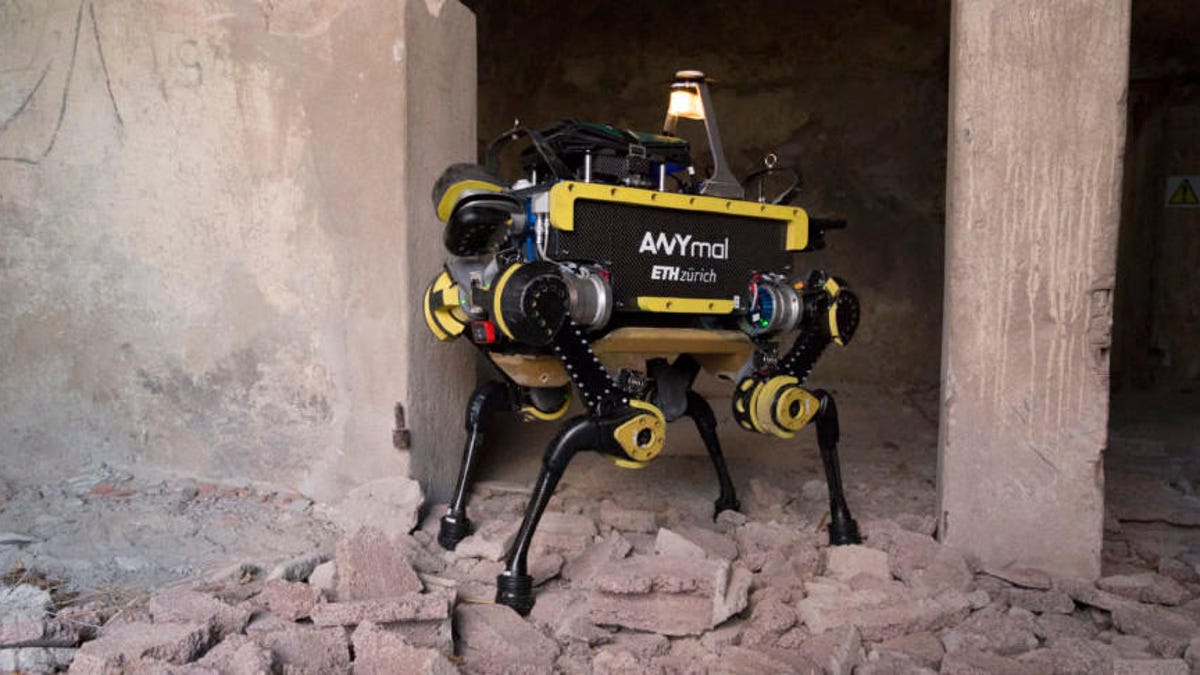Scientists teach a robot dog to get back up after they kick it down
Researchers teach their robot canine to "roll over", which is both terrifying and adorable.

The relationship between humans and dog-like robots seemingly follows this timeline:
- Humans make robotic dog creatures that can open doors.
- Humans antagonize robotic dog creatures by kicking them and knocking them over.
- Robotic dog creatures rise up and enslave the humans.
OK, so the last point may not be necessarily true (yet), but the first two points certainly are. And to prove it, new research published by Science Robotics on Jan. 16 shows another four-legged robot that we like sticking the boot in.
ANYmal, which you may remember from previous creepy-door-opening scenarios, is being designed by researchers at Robotic Systems Lab at ETH Zurich university in Switzerland. Like the quadrupedal creations you're likely more familiar with out of Boston Dynamics (SpotMini) and MIT (Cheetah), ANYmal is a four-legged dog-like robot weighing about 30 kilograms and is primarily being designed to help with industrial inspection of oil and gas sites.
Designing the programs and algorithms that control the robo-beasts is hard work and something that remains a challenge for roboticists. There are a lot of moving parts and the suite of sensors, contacts and cameras all relay a lot of information at once, and the robot has to sift through these rapidly just to walk or stay upright.
The team at Robotics Systems Labs are trying to make that process a little easier.
They're training ANYmal in complicated behaviours such as walking, running and recovering from falls by using computer simulation data. Using their simulation platform, a regular desktop computer can simulate over 2,000 ANYmals at once, and the data that is accumulated can be transferred to the robot. That transfer helped train ANYmal to walk using less energy and less torque and helped ANYmal beat the previous speed record by 25 percent.
But that wasn't all. That doesn't fit into the humans and robot dogs timeline. So, like Ian Moss' classic "Tucker's Daughter" once told us: Build them up, just to tear them down.
Which means, of course, the researchers also had to kick the dog.
Nothing to see here, everything is fine.
When ANYmal was knocked over, the simulation data -- which the team calls an "extremely complicated recovery task" -- was able to restore the ANYmal to a standing position for 100 percent of the trials. In fact, the simulation data helped ANYmal to roll itself out of the bind like a good boy, rather than flail like an upturned turtle.
That's critical to removing human intervention from the process. If the robot can stand up on its own from a fall of any kind, then it makes it much more valuable in situations where it may need to cross uneven terrain for say, a rescue mission. Another benefit of the training via simulation is the cost gets driven down, but development times are scaled up.
A video detailing the process can be seen below:
The research team explains in their paper how a cost-effective, fast, automated quadrupedal robot "may one day rescue people in forests and mountains, climb stairs to carry payloads in construction sites, inspect unstructured underground tunnels, and explore other planets."
No word, though, on whether or not a robotic dog uprising is likely to occur before that. We'd hedge our bets.
CES 2019: See all of CNET's coverage of the year's biggest tech show.
Everything about Fortnite: What you need to know about the hit game.

